

Hexagonal bolts are now more widely used in the fastener industry. Compared with the one-type and cross-type head, its assembly is not easy to slip teeth, and the torque is also higher. Compared with dodecagonal and multi-tooth head, its structure is simple and cost is lower. As a result, hexagonal bolts have a higher overall price and are the most used type of bolts in automobiles today.
Hexagonal bolts can be categorized into outer hexagonal bolts and socket bolts, what is the difference between these two types of bolts? Below we introduce them from several aspects, including structure, cost, tightening tools, advantages and disadvantages, and application scope.
Framework:
From a structural point of view, outer hexagonal bolts and socket bolts are easy to recognize. There is basically no difference in the threaded part, the outer hexagonal is a hexagonal head, the sides of the head of the outer hexagon are hexagonal and the head has no grooves. In order to increase the pressure-bearing area of the head, they can also be made into hexagonal flange bolts, and this variant is also very widely used.
socket bolts that head with a rounded outer head and a square inner head with a recessed hexagonal center are more commonly known as cylindrical head hexagonal, while disc head hexagonal, countersunk head hexagonal, flat head hexagonal, etc. are all known as headless hexagonal.
Of course, scoket bolts can also be made into socket flange bolts to increase the head contact area.
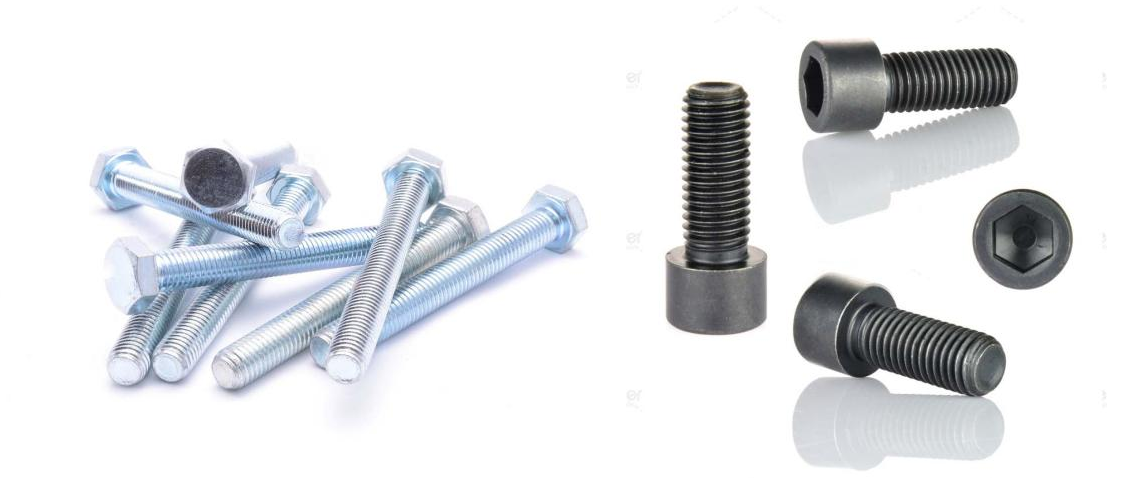
In order to control the friction coefficient of the head of the bolt or to improve the anti-loosening performance,also can outer hexagon combination bolts and hexagon socket combination bolts,as shown in the figure below.

Costs:
socket and hexagonal bolts are generally threaded by thread rolling, the use of thread rolling plate is basically the same, there is no significant difference in cost.
The difference is the head manufacturing process, because the head structure is completely different, need to use different molds and processes, the head manufacturing cost of socket bolts is higher than the head manufacturing cost of hexagonal threads, hexagonal bolts cost only half of the socket bolts.
Tightening tools:
Here can be divided into life and production assembly.
Assembly in life, socket bolts with the shape of the wrench is "L" type, one side of the long side of the short side of the screw, the short side of the screw, the long side of the hand can save energy and better tighten the screws. Hexagonal bolts is the head into an equal hexagonal wrench, such as wrenches, wrenches and open-end wrenches. As shown in the picture below, who have done daily assembly or repairs at home should be familiar with the following two tools.
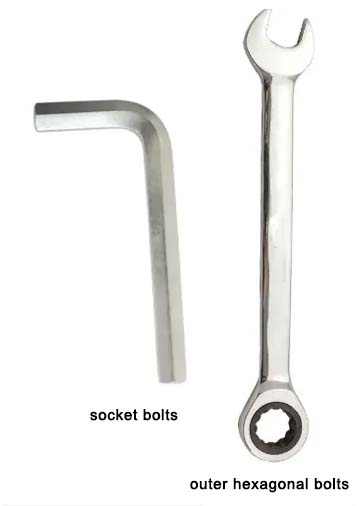
Assembly in production, in order to ensure the tightening quality and automation requirements, will be through the constant value torque wrenches and high-precision tightening gun for assembly, so it is necessary to match the corresponding tightening sleeve, hex bolts of the sleeve is concave hexagonal, socket bolts of the sleeve is convex hexagonal, as shown in the figure below, the two according to the size of the head of the bolt there will be a series of sizes to match the sleeve.
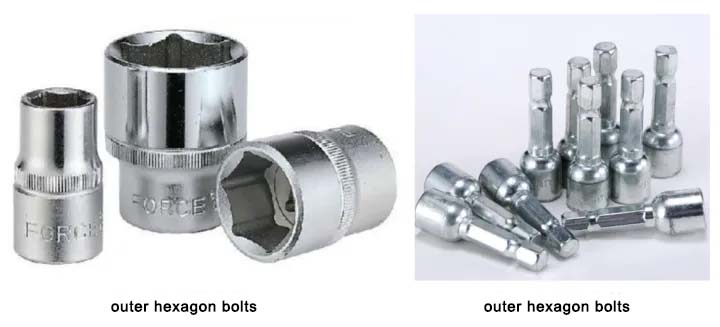
Advantages and Disadvantages:
Advantages:
Outer hexagonal bolts: good self-locking; large preload contact area and preload force; wider range of full-thread lengths; reamed holes can be present, capable of fixing the position of the parts and withstanding shear caused by transverse forces; the head is thinner than that of the hexagonal socket, which can not be replaced by the hexagonal socket in some places.
socket bolts: easy to fasten; not easy to dismantle; not easy to slip angle; take up little space; withstand a larger load; can be countersunk, can be sunk inside the workpiece, more compact, beautiful, will not interfere with other parts.
Disadvantages:
Outer hexagonal bolts: take up more space, less suitable for more delicate occasions; can not be used for countersunk head.
Socket bolts: small contact area, small preload; over a certain length without a full thread; fastening tools are not good with, screwing up easy to slip, replacement is not convenient; disassembly with a professional wrench, usually not good to dismantle.
Scope of application:
It is the advantages and disadvantages of external hex bolts and socket bolts, so how to choose in the application?
If the axial force required at the tightening point is large, i.e., the torque of tightening is large, and there is sufficient space for external tightening, the outer hexagonal bolt is used for tightening.
If the tightening position has space limitations, or aesthetic made of countersunk head demand, while the tightening point of the required axial force is not large, that is, the tightening torque is not large, at this time can be made socket bolt.
In the car, for example, the sub-frame and body connection position, a few bolts through the bottom through the sub-frame, tightened to the body, because the bottom is not visible area, no aesthetic requirements, tightening there is no interference, and tightening the required axial force and torque is greater (bolts over yield tightening), for this connection position is suitable for the use of outer hexagon bolts to tighten.
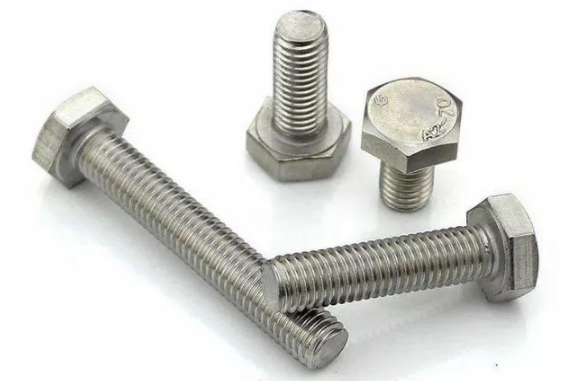
The connection of interior parts, which is the visible area of the customer, usually has aesthetic requirements, and needs to be made countersunk structure, the top of the bolt head needs to be kept in a plane with the structure of the connected parts, or the outside also needs to be added a layer of coverings, and the tightening axial force and torque of such positions are also smaller. Therefore, it is very suitable for tightening with socket bolts or screws.
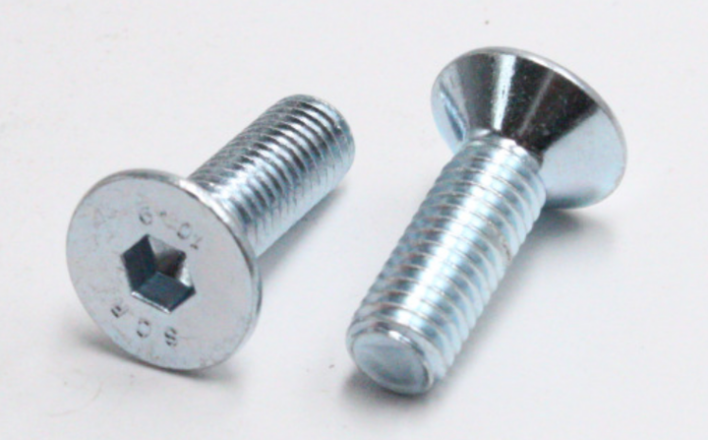
If it is not quite clear how to choose, then look at the connection position there is no delicate, beautiful, assembly space limitations requirements, if so, then choose socket bolts / screws. If not, then choose outer hexagonal bolts/screws, after all, outer hexagonal bolts are cheaper and other requirements can be basically satisfied. This is why outer hexagon bolts/screws are more widely used than hexagon bolts/screws.
Summarize:
Hexagon head bolts / screws because of the simple structure, easy to use, affordable, tightening is not easy to fail and other advantages are currently widely used in various industries, the common hexagon head bolts / screws have an external outer hexagonal and socket two structures.
Structure, look at the two head structure can be clearly distinguished; cost of the outer hexagon for the hexagonal bolt price of half; Both in life and in production, its tightening tools are different; according to the advantages and disadvantages of the two, the application, such as connecting the position of the delicate, beautiful, assembly space limitations of the requirements of the choice of the socket bolts / screws, such as the lack of such requirements, choose the outer hexagonal head bolts / screws.